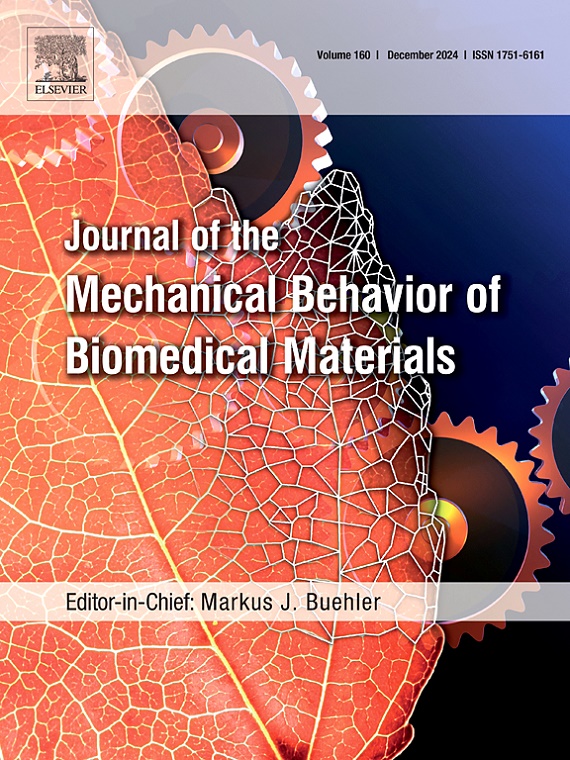瓷贴面二硅酸锂和氧化锆牙冠的热应力:使用有效粘弹性有限元模型的比较分析。
IF 3.3
2区 医学
Q2 ENGINEERING, BIOMEDICAL
Journal of the Mechanical Behavior of Biomedical Materials
Pub Date : 2025-01-17
DOI:10.1016/j.jmbbm.2025.106895
引用次数: 0
摘要
本研究旨在探讨材料相容性、可变冷却速率和牙冠几何形状对烤瓷贴面二硅酸锂(PVLD)和烤瓷贴面氧化锆(PVZ)牙冠系统热应力发展的影响,并随后预测其最佳性能参数。利用实验冠样本的3D扫描生成的STL文件,开发了解剖学正确的3D冠模型。其次,建立了基于三维冠模型的粘弹性有限元模型(VFEM),并对解剖正确的双层PVLD和PVZ冠系统进行了验证。采用维氏压痕法对实验PVLD和PVZ冠试样进行了数值模拟,验证了数值模拟的热应力结果。验证的VFEM然后用于预测牙冠系统内的热瞬态和残余应力。PVLD冠与PVZ冠的热残余应力分布对比表明,PVLD冠的界面应力浓度相对较低。然而,PVLD冠在贴面层也经历了显著的拉应力。此外,快速冷却方案被认为会导致PVLD和PVZ冠的外贴面压应力加剧,从而增强抗裂纹扩展的能力。但更快的冷却速度也会导致快速的应力演变,这可能会导致冠内的材料缺陷。本研究通过比较PVLD和PVZ冠内的应力分布,强调了材料相容性的重要性。此外,烧成后的冷却方案对整体热应力分布有显著影响,从而影响牙冠的长期性能。本文章由计算机程序翻译,如有差异,请以英文原文为准。
Thermal stresses in porcelain veneered lithium disilicate and zirconia dental crowns: Comparative analysis using a validated viscoelastic finite element model
This study aims to investigate the effects of material compatibility, variable cooling rates, and crown geometry on thermal stress development in porcelain-veneered lithium disilicate (PVLD) and porcelain-veneered zirconia (PVZ) dental crown systems, and subsequently anticipate parameters for their optimum performance. An anatomically correct 3D crown model was developed from STL files generated using 3D scans of the experimental crown sample. Next, the viscoelastic finite element model (VFEM) based on the 3D crown model was developed and validated for anatomically correct bilayer PVLD and PVZ crown systems. The Vicker's indentation method was used on experimental PVLD and PVZ crown samples to validate the simulated thermal stress results from the VFEM. The validated VFEM was then used to predict thermal transient and residual stresses within the dental crown systems. The comparison between thermal residual stress profiles in PVLD and PVZ crowns showed that the interfacial stress concentrations were comparatively lower for PVLD crowns. However, the PVLD crowns also experienced prominent tensile stresses in the veneer layer. Furthermore, the rapid cooling protocol was seen to cause intensification of compressive stresses on the exterior veneer surface for both PVLD and PVZ crowns which can enhance resistance against crack growth. But faster cooling rates also caused rapid stress evolution which may cause material defects within the crown. This study highlights the importance of material compatibility by comparing stress distribution within the PVLD and PVZ crowns. Moreover, the post-firing cooling protocols showed significant effects on overall thermal stress distribution and consequently, the long-term dental crown performance.
求助全文
通过发布文献求助,成功后即可免费获取论文全文。
去求助
来源期刊

Journal of the Mechanical Behavior of Biomedical Materials
工程技术-材料科学:生物材料
CiteScore
7.20
自引率
7.70%
发文量
505
审稿时长
46 days
期刊介绍:
The Journal of the Mechanical Behavior of Biomedical Materials is concerned with the mechanical deformation, damage and failure under applied forces, of biological material (at the tissue, cellular and molecular levels) and of biomaterials, i.e. those materials which are designed to mimic or replace biological materials.
The primary focus of the journal is the synthesis of materials science, biology, and medical and dental science. Reports of fundamental scientific investigations are welcome, as are articles concerned with the practical application of materials in medical devices. Both experimental and theoretical work is of interest; theoretical papers will normally include comparison of predictions with experimental data, though we recognize that this may not always be appropriate. The journal also publishes technical notes concerned with emerging experimental or theoretical techniques, letters to the editor and, by invitation, review articles and papers describing existing techniques for the benefit of an interdisciplinary readership.
 求助内容:
求助内容: 应助结果提醒方式:
应助结果提醒方式:


